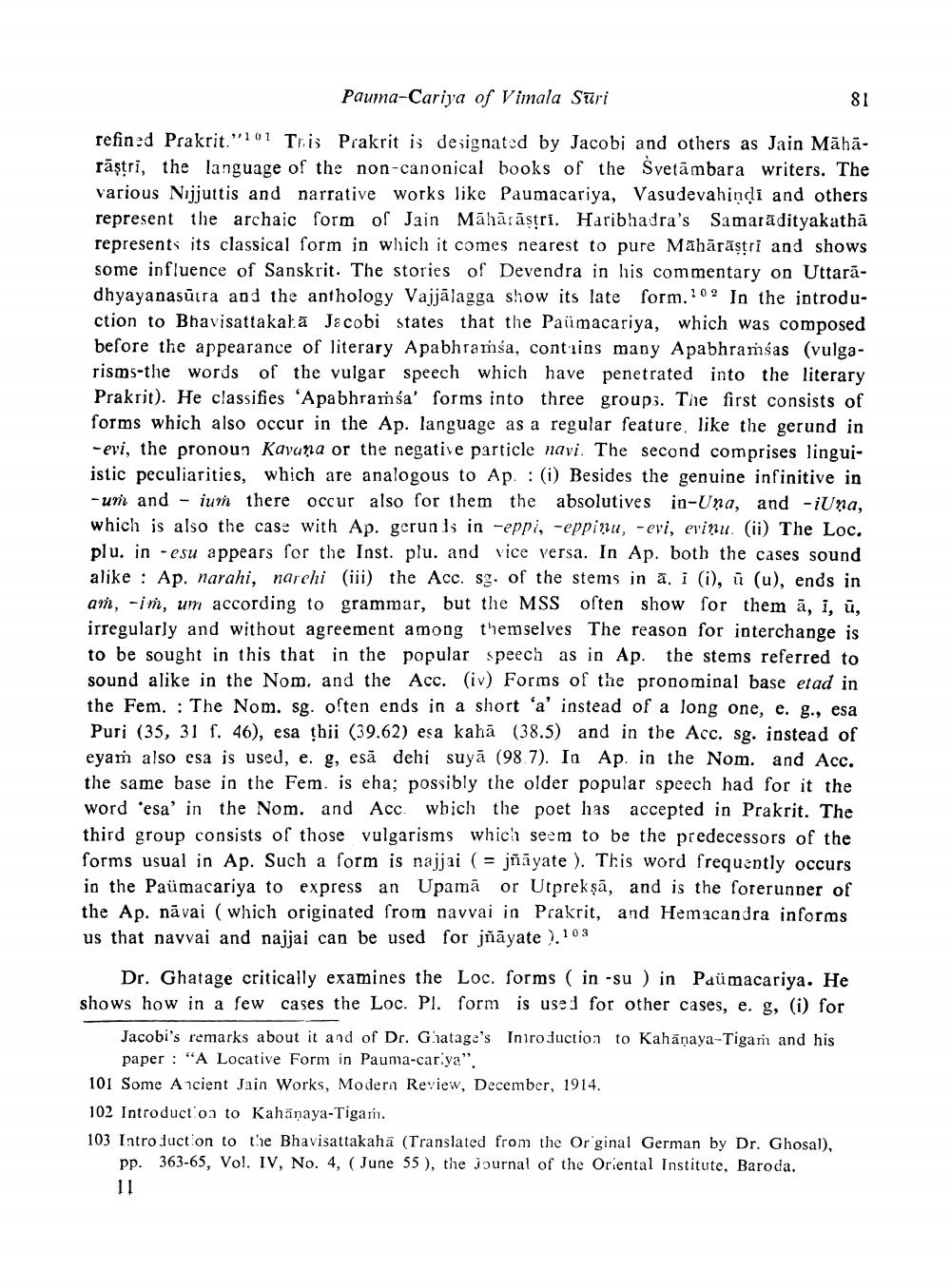________________
Pauma-Cariya of Vimala Sūri
81
refined Prakrit."101 Tris Prakrit is designated by Jacobi and others as Jain Māhārāştri, the language of the non-canonical books of the Svetāmbara writers. The various Nijjuttis and narrative works like Paumacariya, Vasudevahindi and others represent the archaic form of Jain Māhārāştri. Haribhadra's Samarādityakathā represents its classical form in which it comes nearest to pure Māhāsāstri and shows some influence of Sanskrit. The stories of Devendra in his commentary on Uttaradhyayanasūira and the anthology Vajjālagga show its late form.:02 In the introduction to Bhavisattakalā Jacobi states that the Paümacariya, which was composed before the appearance of literary Apabhramsa, contrins many Apabhramśas (vulgarisms-the words of the vulgar speech which have penetrated into the literary Prakrit). He classifies 'Apabhraíśa' forms into three groups. The first consists of forms which also occur in the Ap. language as a regular feature, like the gerund in -evi, the pronoun Kavana or the negative particle navi. The second comprises linguiistic peculiarities, which are analogous to Ap. : (i) Besides the genuine infinitive in -un and - ium there occur also for them the absolutives in-Una, and -iUņa, which is also the case with Ap. gerun is in -eppi, -eppinu, -evi, eviņu. (ii) The Loc. plu. in - esu appears for the Inst. plu. and vice versa. In Ap. both the cases sound alike : Ap. narahi, narchi (iii) the Acc. sg. of the stems in a. i (i), ū (u), ends in am, -im, um according to grammar, but the MSS often show for them ā, i, ū, irregularly and without agreement among themselves The reason for interchange is to be sought in this that in the popular speech as in Ap. the stems referred to sound alike in the Nom, and the Acc. (iv) Forms of the pronominal base etad in the Fem. : The Nom. sg. often ends in a short 'a' instead of a long one, e. g., esa Puri (35, 31 f. 46), esa thji (39.62) esa kahā (38.5) and in the Acc. sg. instead of eyam also esa is used, e. g, esā dehi suyā (98 7). In Ap. in the Nom. and Acc. the same base in the Femis eha; possibly the older popular speech had for it the word 'esa' in the Nom. and Acc. which the poet has accepted in Prakrit. The third group consists of those vulgarisms which seem to be the predecessors of the forms usual in Ap. Such a form is najjai ( = jñāyate ). This word frequently occurs in the Paümacariya to express an Upamā or Utpreksā, and is the forerunner of the Ap. nāvai ( which originated from navvai in Prakrit, and Hemacandra informs us that navvai and najjai can be used for jñāyate). 103
Dr. Ghatage critically examines the Loc. forms ( in -su ) in Paümacariya. He shows how in a few cases the Loc. Pl. form is used for other cases, e. g, (i) for
Jacobi's remarks about it and of Dr. Gratage's Introduction to Kahāņaya-Tigam and his
paper : "A Locative Form in Pauma-car.ya". 101 Some Ancient Jain Works, Modern Review, December, 1914. 102 Introduction to Kahanaya-Tigam. 103 Introduction to the Bhavisattakahā (Translated from the Orginal German by Dr. Ghosal),
pp. 363-65, Vol. IV, No. 4, (June 55), the journal of the Oriental Institute, Baroda. 11




